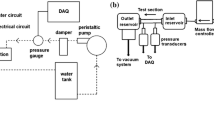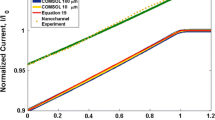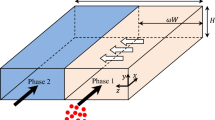Abstract
In liquid–liquid extraction, counter-current flow of the phases always results in an improved performance as compared to co-current flow, under similar operating conditions. However, it is challenging to implement counter-current flow in a microchannel. Therefore, the improvement in extraction performance must be significant to justify the selection of counter-current flow over co-current flow in microchannels. In this study, we identify the range of fluid properties and operating conditions for which counter-current operation exhibits significant benefits. For this, simplified mathematical models are developed for both co-current and counter-current extraction in the stratified flow regime. These models, while being simple, capture the essential physics of the extraction process and facilitate a thorough investigation of the relative extraction performance across the parameter space. An analytical solution, based on the theory of Sturm–Liouville linear operators, is obtained for the case of co-current flow. The counter-current model belongs to the class of two-way diffusion equations for which a novel semi-analytical solution is presented. The analysis of the predictions of the models shows that the relative extraction performance is governed by a general principle of maximum gain at mediocre performance. These results help identify the significantly restricted range of operating parameters for which counter-current operation is a truly attractive alternative to the co-current mode of extraction in microchannels.










Similar content being viewed by others
Abbreviations
- y :
-
Coordinate along the channel width
- x :
-
Coordinate along the channel length
- i :
-
Index: 1 denotes carrier phase and 2 denotes solvent phase
- c i :
-
Concentration of solute in each fluid phase
- v i :
-
Plug flow velocities of each fluid phase
- \(D_{i}\) :
-
Diffusivity of solute in each fluid phase
- \(h\) :
-
Location of the interface
- \(H\) :
-
Width of the channel
- \(h_{\text{r}}\) :
-
Location of the interface as a fraction of total channel width
- \(K\) :
-
Equilibrium coefficient of solute concentration
- \(C_{\text{in}}\) :
-
Initial concentration in entering carrier stream
- \({\text{Pe}}_{i}\) :
-
Peclet number in each fluid phase (Eq. 8 for the co-current problem and Eq. 16 for the counter-current problem as well as parameter studies)
- \(\beta\) :
-
Ratio of diffusivities
- \(\varphi_{i,n} (y)\) :
-
nth eigen function in each fluid phase (co-current problem)
- \(\lambda_{n}\) :
-
nth eigen value (co-current problem)
- \({\text{ER}}\) :
-
Extraction ratio (Eq. 37)
- \({\text{RER}}\) :
-
Relative extraction ratio (Eq. 38)
References
Aota A, Nonaka M, Hibara A, Kitamori T (2007) Countercurrent laminar microflow for highly efficient solvent extraction. Angew Chem Int Ed 46:878–880
Beals R (1981) Partial range completeness and existence of solutions to twoway diffusion equations. J Math Phys 22:954–960
Fisch NJ, Kruskal MD (1980) Separating variables in twoway diffusion equations. J Math Phys 21(4):740–750
Fitt V, Ockendon JR, Shillor M (1985) Counter-current mass transfer. Int J Heat Mass Transf 28:753–759
Fries DM, Voitl T, Rohr PR (2008) Liquid extraction of vanillin in rectangular microreactors. Chem Eng Technol 31:1182–1187
Gao Y, Wong T, Yang C, Ooi K (2005) Two-fluid electroosmotic flow in microchannels. J Coll Interface Sci 284:306–314
Hagan SP, Ockendon JR (1991) Half-range analysis of a counter-current separator. J Math Anal Appl 160:358–378
Hotokezaka H, Tokeshi M, Harada M, Kitamori T, Ikeda Y (2005) Development of the innovative nuclide separation system for high-level radioactive waste using microchannel chip—extraction behavior of metal ions from aqueous phase to organic phase in microchannel. Prog Nucl Energy 47:439–447
Kamholz AE, Schilling EA, Yager P (2001) Optical measurement of transverse molecular diffusion in a microchannel. Biophys J 80:1967–1972
Kashid MN, Harshe YM, Agar DW (2007) Liquid–Liquid slug flow in a capillary: an alternative to suspended drop or film contactors. Ind Eng Chem Res 46:8420–8430
Kashid MN, Renken A, Kiwi-Minsker L (2011a) Gas–liquid and liquid–liquid mass transfer in microstructured reactors. Chem Eng Sci 66:3876–3897
Kashid MN, Renken A, Kiwi-Minsker L (2011b) Influence of flow regime on mass transfer in different types of microchannels. Ind Eng Chem Res 50:6906–6914
Kuban P, Berg J, Dasgupta PK (2003) Vertically stratified flows in microchannels. Computational simulations and applications to solvent extraction and ion exchange. Anal Chem 75:3549–3556
Liu M, Liu Y, Guo QYJ (2009) Modeling of electroosmotic pumping of nonconducting liquids and bio fluids by a two-phase flow method. J Electroanal Chem 636:86–92
Malengier B, Pushpavanam S (2012) Comparison of co-current and counter-current flow fields on extraction performance in micro-channels. Adv Chem Eng Sci 2:309–320
Malengier B, Tamalapakula JL, Pushpavanam S (2012) Comparison of laminar and plug flow-fields on extraction performance in micro-channels. Chem Eng Sci 83:2–11
Okubo Y, Maki T, Aoki N, Khoo TH, Ohmukai Y, Mae K (2008) Liquid-liquid extraction for efficient synthesis and separation by utilizing micro spaces. Chem Eng Sci 63:4070–4077
Plazl PZ, Plazl I (2007) Steroid extraction in a microchannel system—mathematical modelling and experiments. Lab Chip 7:883–889
Ramkrishna D, Amundson NR (1974) Transport in composite materials: reduction to a self adjoint formalism. Chem Eng Sci 29:1457–1464
Ramkrishna D, Amundson NR (1985) Linear operator methods in chemical engineering with applications to transport and chemical reaction systems. Prentice-Hall, Englewood Cliffs
Sato K, Hibara A, Tokeshi M, Hisamoto H, Kitamori T (2003) Microchip-based chemical and biochemical analysis systems. Adv Drug Deliv Rev 55:379–391
Treybal RE (1980) Interphase mass transfer. In: Mass-transfer operations, 3rd edn. Mc-Graw Hill, Singapore
Acknowledgments
The first author (J.R.P) thanks Prof. R. Ravi of the Chemical Engineering Department at IIT Madras for introducing him to the elegant mathematical theory of linear operators in Hilbert space.
Author information
Authors and Affiliations
Corresponding author
Appendix: analytical solution of the co-current model
Appendix: analytical solution of the co-current model
The details of the solution of the co-current concentration field are given in this appendix. Here the solution is presented within the framework of linear operator theory. Entirely equivalent results may be obtained by the well-known ‘separation of variables’ method of solution.
Equation (9) may be represented concisely in linear operator form as
Here L is a Sturm–Liouville operator defined on the Hilbert Space \( \cal{L}[\text{0,1}] \)
where c(y) is a piecewise continuous function. It is continuous everywhere except at the interface. v r(y) and Pe are piecewise constant functions given by
Following the treatment of Ramkrishna and Amundson (1974), we define an inner product which renders the operator L self-adjoint.
In this inner product, it can be seen that L is self-adjoint, i.e., it satisfies
Such a self-adjoint operator on the Hilbert space \( \cal{L}[\text{0,1}] \) can be shown to possess a discrete spectrum of eigen values. The corresponding eigen functions form an orthonormal basis (Ramkrishna and Amundson 1974, 1985). Thus, we can represent the solution as
where ϕ n (y) is the nth orthonormal eigen function. The eigen functions are also piecewise continuous with a single point of discontinuity at the interface. The eigen value problem is given by
The eigen values of the operator L are non-negative. This fact is made explicit by representing them as \(\lambda_{n}^{2}\). The coefficients of the eigen functions in Eq. (44) are obtained by taking the inner product of Eq. (39) with ϕ n (y) and applying Eq. (45).
On solving this ordinary differential equation and substituting the result in Eq. (44), we obtain the infinite series solution as
The eigen values and eigen functions are obtained by solving the eigen value problem of Eq. (45). The general solution to Eq. (45) is
Here \(\lambda_{n}^{{}}\) is the positive root of \(\lambda_{n}^{2}\). The no-flux boundary conditions in Eq. (10) require that A = C = 0. The boundary conditions at the interface give rise to a set of two homogeneous linear algebraic equations. For non-trivial solutions to Eq. (45), the determinant of this system of equations must vanish. This yields the characteristic equation which determines the eigen values.
Equation (44) is transcendental in \(\lambda_{n}^{{}}\) and must be solved numerically. Care should be taken to insure that all eigen values are obtained. Further, they must be paired correctly with the corresponding eigen functions in the series solution. The eigen functions are given by
where b n and d n are evaluated to insure orthonormality of the eigen functions according to the definition of the inner product in Eq. (42).
Equation (49) admits a zero eigen value. The corresponding eigen function is
Substituting Eqs. (50)–(53) in Eq. (47), one obtains the solution as given in Eq. (14).
Rights and permissions
About this article
Cite this article
Picardo, J.R., Pushpavanam, S. On the conditional superiority of counter-current over co-current extraction in microchannels. Microfluid Nanofluid 15, 701–713 (2013). https://doi.org/10.1007/s10404-013-1173-1
Received:
Accepted:
Published:
Issue Date:
DOI: https://doi.org/10.1007/s10404-013-1173-1




